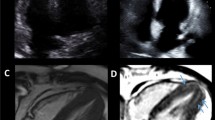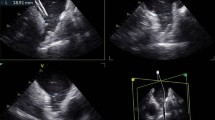Abstract
Purpose of Review
Accurate procedural guidance is necessary for structural heart disease (SHD) interventions to reduce procedural times and improve results. Fluoroscopy remains the foundation imaging modality for guidance of transcatheter therapy. However, fluoroscopy has limitations in that it only provides 2D projections of complex 3D anatomy. Fusion technology has the capability to project cardiac imaging, including echocardiography and computed tomography (CT), onto fluoroscopy for a more complete representation of the anatomy to help guide SHD interventions. This in turn allows for a more effective workflow that may improve safety and efficacy while decreasing procedural times, radiation exposure, and contrast dosage. This review focuses on the use of fusion imaging for SHD interventions.
Recent Findings
Recent studies support the feasibility of fusion imaging for a variety of SHD interventions. The impact of fusion imaging on operator confidence, procedural success rates, and outcome measures, such as procedure time and radiation exposure, are currently being evaluated.
Summary
The use of echocardiography-fluoroscopy and computed tomography angiography (CTA)-fluoroscopy fusion imaging has been established for a multitude of SHD interventions. While fusion imaging has the potential to improve SHD interventions, data is mainly limited to observational studies. Therefore, future studies are needed to evaluate if fusion imaging leads to an improvement in procedural success and a reduction in procedural time, radiation exposure, and contrast dose.








Similar content being viewed by others
Abbreviations
- CTA:
-
Computed tomography angiography
- ICE:
-
Intracardiac echocardiography
- LAA:
-
Left atrial appendage
- MR:
-
Magnetic resonance imaging
- PVL:
-
Paravalvular leak
- PMVR:
-
Percutaneous mitral valve repair
- RT-3D:
-
Real-time three-dimensional
- SHD:
-
Structural heart disease
- TAVR:
-
Transaortic valve replacement
- TEE:
-
Transesophageal echocardiography
- TTE:
-
Transthoracic echocardiography
- TS:
-
Transseptal puncture
- ViV:
-
Valve-in-valve
- ViR:
-
Valve-in-ring
References
Papers of particular interest, published recently, have been highlighted as: •• Of major importance
Alkhouli M, Rihal CS, Holmes DR Jr. Transseptal techniques for emerging structural heart interventions. J ACC Cardiovasc Interv. 2016;9(24):2465–80.
Afzal S, Veulemans V, et al. Safety and efficacy of transseptal puncture guided by real-time fusion of echocardiography and fluoroscopy. Neth Heart J. 2017;25(2):131–6.
Faletra FF, Biasco L, Pedrazzini G, Moccetti M, Pasotti E, Leo LA, Cautilli G, et al. Echocardiographic-Fluoroscopic Fusion Imaging in Transseptal Puncture: A New Technology for an Old Procedure. J Am Soc Echocardiogr. 2017;30(9):886–895.
Pitta SR, Cabalka AK, Rihal CS. Complications associated with left ventricular puncture. Catheter Cardiovasc Interv. 2010;76:993–7.
Brock R, Milstein BB, Ross DN. Percutaneous left ventricular puncture in the assessment of aortic stenosis. Thorax. 1956;11:163–71.
Brown SC, Boshoff DE, Rega F, et al. Transapical left ventricular access for difficult to reach interventional targets in the left heart. Catheter Cardiovasc Interv. 2009;74:137–42.
Lim DS, Ragosta M, Dent JM. Percutaneous transthoracic ventricular puncture for diagnostic and interventional catheterization. Catheter Car- diovasc Interv. 2008;71:915–8.
Kliger C, Jelnin V, Sharma S, Panagopoulos G, Einhorn BN, Kumar R, et al. CT angiography–fluoroscopy fusion imaging for percutaneous transapical access. J Am Coll Cardiol Img. 2014;7(2):169–77.
•• Biaggi P, Fernandez-Golfín C, Hahn R, Corti R. Hybrid imaging during transcatheter structural heart interventions. Curr Cardiovasc Imaging Rep. 2015;8(9):33. Excellent reviews on echocardiography-fluoroscopy fusion imaging for structural heart disease intervention.
Sundermann SH, Biaggi P, Grunenfelder J, Gessat M, Felix C, Bettex D, et al. Safety and feasibility of novel technology fusing echocardiography and fluoroscopy images during MitraClip interventions. EuroIntervention. 2014;9:1210–6.
Pasala Tilak KR, Jelnin V, Kronzon I, Ruiz CE. Fusion Imaging for paravalvular leak closure. In: Smolka G, Wojakowski W, Tendera M, editors. Transcatheter paravalvular leak closure. Singapore: Springer; 2018. Print.
Jilaihawi H, Doctor N, Kashif M, Chakravarty T, Rafique A, Makar M, et al. Aortic annular sizing for transcatheter aortic valve replacement using cross-sectional 3-dimensional transesophageal echocardiography. J Am Coll Cardiol. 2013;61:908–16.
Kempfert J, Noettling A, John M, Rastan A, Mohr FW, Walther T. Automatically segmented DynaCT: enhanced imaging during transcatheter aortic valve implantation. J Am Coll Cardiol. 2011;58:e211.
Madershahian N, Weber C, Majd P, Rudolph T, Kuhn E, Scherner M, et al. Feasibility and applicability of static vascular outline roadmapping during TAVI. J Cardiovasc Surg. 2017; https://doi.org/10.23736/S0021-9509.17.10095-9.
Vaitkus PT, Wang DD, Greenbaum A, Guerrero M, O’Neill W. Assessment of a novel software tool in the selection of aortic valve prosthesis size for transcatheter aortic valve replacement. J Invasive Cardiol. 2014;26(7):328–32.
Perk G, Biner S, Kronzon I, Saric M, Chinitz L, Thompson K, Shiota T, Hussani A, Lang R, Siegel R, Kar S. Catheter-based left atrial appendage occlusion procedure: role of echocardiography. Eur Heart J Cardiovasc Imaging. 2012;13(2):132–8.
•• Thaden JJ, Sanon S, Geske JB, Eleid MF, Nijhof N, Malouf JF, et al. Echocardiographic and Fluoroscopic Fusion Imaging for Procedural Guidance: An Overview and Early Clinical Experience. J Am Soc Echocardiogr. 2016;29(6):503–12. Excellent reviews on echocardiography-fluoroscopy fusion imaging for structural heart disease intervention.
Jungen C, Zeus T, Balzer J, Eickholt C, Petersen M, Kehmeier E, Veulemans V, Kelm M, Willems S, Meyer C. Left atrial appendage closure guided by integrated echocardiography and fluoroscopy imaging reduces radiation exposure. PLoS One. 2015;10(10).
Housden RJ, Arujuna A, Ma Y, Nijhof N, Gijsbers G, Bullens R, et al. Evaluation of a real-time hybrid three-dimensional echo and X-ray imaging system for guidance of cardiac catheterisation procedures. Med Image Comput Comput Assist Interv. 2012;15(Pt 2):25–32.
Grant EK, et al. Image fusion guided device closure of left ventricle to right atrium shunt. Circulation. 2015;132(14):1366–7.
McGuirt D, et al. X-ray fused with magnetic resonance imaging to guide endomyocardial biopsy of a right ventricular mass. Radiol Technol. 2016;87(6):622–6. Print
Author information
Authors and Affiliations
Corresponding author
Ethics declarations
Conflict of Interest
Craig Basman, Tilak K.R. Pasala, and Yuvrajsinh Parmar have no conflicts of interest.
Itzhak Kronzon, Chad Kliger, Vladimir Jelnin, and Carlos E. Ruiz receive consulting fees from Philips.
Human and Animal Rights and Informed Consent
This article does not contain any studies with human or animal subjects performed by any of the authors.
Additional information
This article is part of the Topical Collection on Echocardiography
Rights and permissions
About this article
Cite this article
Basman, C., Parmar, Y.J., Kliger, C. et al. Fusion Imaging for Structural Heart Disease Interventions. Curr Cardiovasc Imaging Rep 10, 41 (2017). https://doi.org/10.1007/s12410-017-9436-y
Published:
DOI: https://doi.org/10.1007/s12410-017-9436-y




